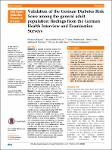Validation of the German Diabetes Risk Score among the general adult population: findings from the German Health Interview and Examination Surveys
Paprott, Rebecca
Mühlenbruch, Kristin
Mensink, Gert
Thiele, Silke
Schulze, Matthias B.
Scheidt-Nave, Christa
Heidemann, Christin
Objective: To evaluate the German Diabetes Risk Score (GDRS) among the general adult German population for prediction of incident type 2 diabetes and detection of prevalent undiagnosed diabetes. Methods: The longitudinal sample for prediction of incident diagnosed type 2 diabetes included 3625 persons who participated both in the examination survey in 1997–1999 and the examination survey in 2008–2011. Incident diagnosed type 2 diabetes was defined as first-time physician diagnosis or antidiabetic medication during 5 years of follow-up excluding potential incident type 1 and gestational diabetes. The cross-sectional sample for detection of prevalent undiagnosed diabetes included 6048 participants without diagnosed diabetes of the examination survey in 2008–2011. Prevalent undiagnosed diabetes was defined as glycated haemoglobin ≥6.5% (48 mmol/mol). We assessed discrimination as area under the receiver operating characteristic curve (ROC-AUC (95% CI)) and calibration through calibration plots. Results: In longitudinal analyses, 82 subjects with incident diagnosed type 2 diabetes were identified after 5 years of follow-up. For prediction of incident diagnosed diabetes, the GDRS yielded an ROC-AUC of 0.87 (0.83 to 0.90). Calibration plots indicated excellent prediction for low diabetes risk and overestimation for intermediate and high diabetes risk. When considering the entire follow-up period of 11.9 years (ROC-AUC: 0.84 (0.82 to 0.86)) and including incident undiagnosed diabetes (ROC-AUC: 0.81 (0.78 to 0.84)), discrimination decreased somewhat. A previously simplified paper version of the GDRS yielded a similar predictive ability (ROC-AUC: 0.86 (0.82 to 0.89)). In cross-sectional analyses, 128 subjects with undiagnosed diabetes were identified. For detection of prevalent undiagnosed diabetes, the ROC-AUC was 0.84 (0.81 to 0.86). Again, the simplified version yielded a similar result (ROC-AUC: 0.83 (0.80 to 0.86)). Conclusions: The GDRS might be applied for public health monitoring of diabetes risk in the German adult population. Future research needs to evaluate whether the GDRS is useful to improve diabetes risk awareness and prevention among the general population.
No license information

